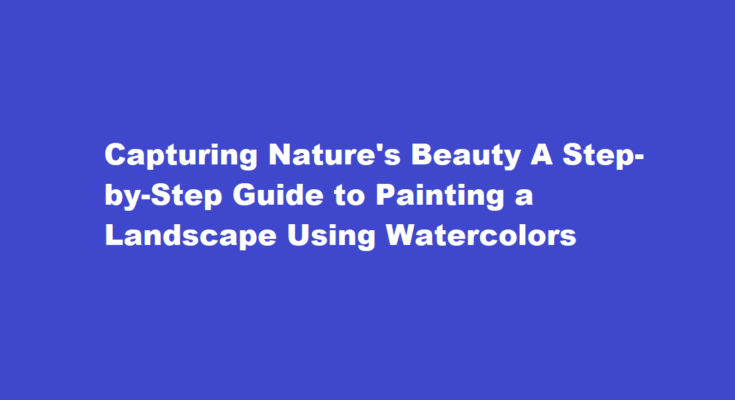Introduction
Watercolor painting is a captivating medium that allows artists to express the serene beauty of landscapes through a blend of color and fluidity. From lush green forests to breathtaking mountain ranges, a watercolor landscape can evoke emotions and transport viewers to the very scene the artist envisioned. In this step-by-step guide, we will explore the essential techniques and tips for creating a stunning watercolor landscape that is uniquely yours. So, grab your watercolors, brushes, and paper as we embark on a creative journey into the heart of nature’s splendor.
Gather Your Materials
Before you begin your artistic endeavor, ensure you have the necessary materials ready. Acquire high-quality watercolor paints, brushes of various sizes, watercolor paper (preferably cold-pressed for added texture), a water container, and a palette for mixing colors. Having the right tools will enhance your painting experience and the overall outcome of your masterpiece.
Sketch Your Composition
A well-thought-out composition is the backbone of any successful landscape painting. Start by sketching the basic outline of your scene using a light pencil. Focus on the placement of prominent elements like trees, mountains, or water bodies. Pay attention to proportion and perspective, ensuring the elements create a visually balanced composition. Don’t be afraid to get creative and make minor adjustments to enhance the appeal of your landscape.
Layering Colors
Begin by moistening your watercolor paper with a clean brush and water, ensuring it remains damp throughout the painting process. Gradually build up the colors in layers, starting with light washes. This technique adds depth and dimension to your landscape. Apply the lightest colors first, allowing each layer to dry before adding another. Work your way from the background to the foreground, gradually intensifying the colors as you proceed.
Mastering Wash Techniques
Watercolor washes are fundamental to landscape painting. There are three main types: flat wash, graded wash, and variegated wash. Practice these techniques to create a smooth and seamless transition of colors. For the sky, use a soft, even wash with light, gentle strokes. Experiment with wet-on-wet and wet-on-dry techniques to achieve different effects for clouds and skies.
Creating Depth and Distance
To portray depth and distance, use lighter and cooler colors for the background and darker and warmer tones for the foreground. This will create the illusion of atmospheric perspective, making the background elements appear farther away. Additionally, softening the edges of distant objects will enhance the sense of depth in your landscape.
Mastering Textures
Textures add interest and realism to your painting. Experiment with various brush strokes and techniques to mimic the texture of different elements in the landscape. For example, use dry brush strokes for rough tree bark, flick your brush to create the illusion of grass, or dab a sponge for textured rocks. Let your creativity flow as you explore the plethora of possibilities.
Focus on the Focal Point
Every captivating landscape painting has a focal point that draws the viewer’s attention. It could be a majestic tree, a charming cottage, or a winding river. Highlight your chosen focal point with more intricate details and vibrant colors, making it the centerpiece of your artwork.
Embrace Mistakes and Experiment
Remember that watercolor painting is fluid and spontaneous. Mistakes can happen, but they can also lead to beautiful, unexpected outcomes. Embrace accidents and view them as opportunities to experiment and add character to your landscape. Use lifting techniques to remove unwanted paint, or add splatters for a whimsical touch.
FREQUENTLY ASKED QUESTIONS
Where do I start with a watercolor landscape?
Start by painting the sky or horizon in your landscape painting, using large brush strokes. Be mindful of details that could impact the perception of your painting, like where the sun is shining. If the sun is on the right side of the painting, this means that the sky will be lighter on that side.
Do you sketch before you watercolor?
Sketches let you test out different compositions before you commit to the final painting. Color palettes are just as important to good looking watercolors. A common mistake is to use too many colors in a painting. Certain combinations of colors produce better color harmonies and reflect mood and atmosphere.
Conclusion
Watercolor landscape painting is a delightful way to express your connection with nature and share its splendor with others. As you continue to practice and explore, you’ll develop your style and techniques, creating unique and captivating landscapes that reflect your artistic journey. So, immerse yourself in the wonders of watercolors, and let your creativity blossom as you paint the beauty of nature onto your canvas. Happy painting!
Read Also : Building a Beautiful Bookshelf from Reclaimed Wood A Step-by-Step Guide



